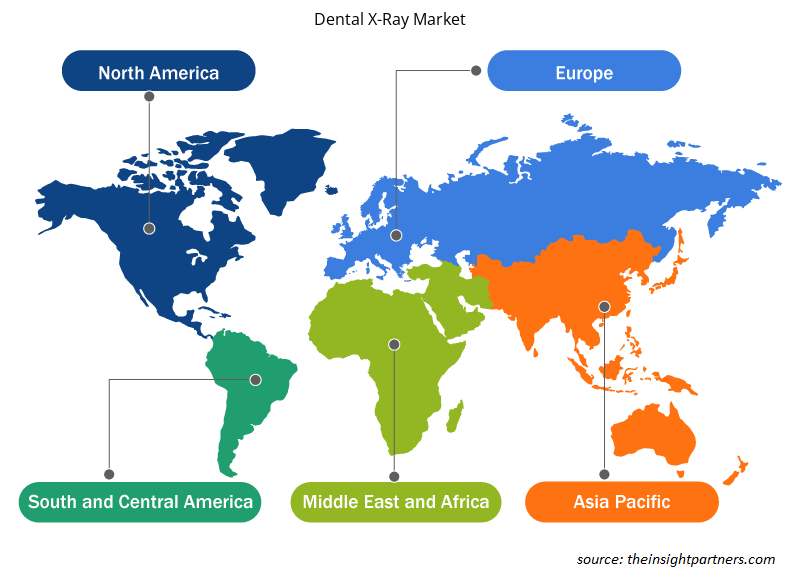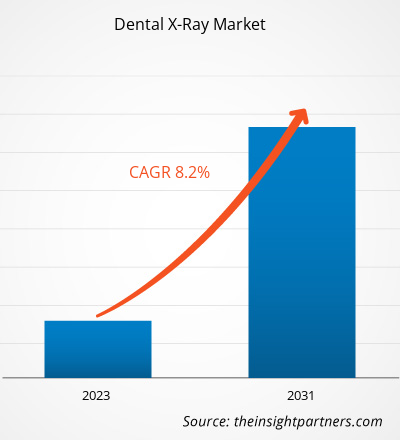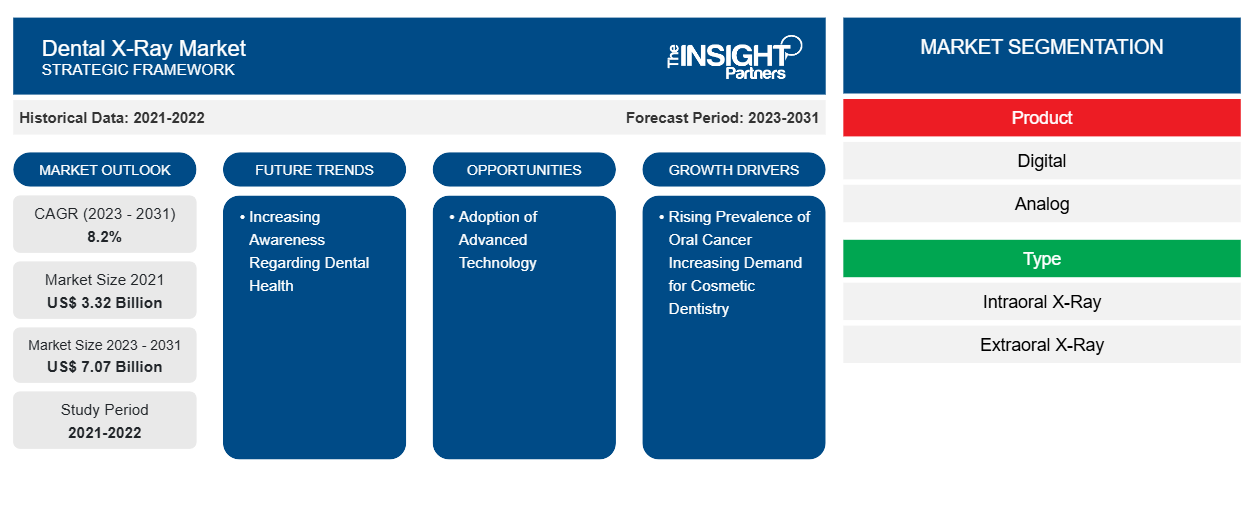La dimensione del mercato dei raggi X dentali nel 2021 era di 3,32 miliardi di dollari USA e si prevede che raggiungerà i 7,07 miliardi di dollari USA entro il 2031 dai XX miliardi di dollari USA del 2023. Si prevede che il mercato registrerà un CAGR dell'8,2% nel 2023-2031. L'adozione di tecnologie avanzate come l'uso del sistema di tomografia computerizzata a fascio conico (CBCT) rimarrà probabilmente una delle tendenze chiave del mercato dei raggi X dentali.
Analisi del mercato dei raggi X dentali
Controlli odontoiatrici regolari, insieme all'uso appropriato dei raggi X, aiutano a mantenere un'eccellente salute orale e a prevenire l'avanzamento delle malattie dentali. La crescente accettazione dell'odontoiatria estetica, i crescenti problemi dentali e la crescente popolazione anziana sono i fattori principali che guidano il mercato dei raggi X dentali.
Panoramica del mercato dei raggi X dentali
I dispositivi diagnostici sono ora richiesti nell'odontoiatria moderna per fornire un'assistenza accurata e completa al paziente. Tra questi strumenti, le radiografie dentali si distinguono come componente essenziale nella diagnosi. Le radiografie dentali si sono sviluppate come uno strumento diagnostico essenziale nell'odontoiatria moderna, migliorando notevolmente la qualità complessiva dell'assistenza al paziente. Dalla diagnosi precoce dei disturbi dentali alla pianificazione accurata del trattamento, i vantaggi delle radiografie sono innegabili.
Personalizza questo report in base alle tue esigenze
Riceverai la personalizzazione gratuita di qualsiasi report, comprese parti di questo report, o analisi a livello nazionale, pacchetto dati Excel, oltre a usufruire di grandi offerte e sconti per start-up e università
-
Scopri le principali tendenze di mercato in questo rapporto.Questo campione GRATUITO includerà analisi di dati che spaziano dalle tendenze di mercato alle stime e alle previsioni.
Driver e opportunità del mercato dei raggi X dentali
L'aumento della prevalenza del cancro orale favorirà la crescita del mercato
L'incidenza di condizioni dentali e orali è in aumento in tutto il mondo, come devitalizzazioni, perdita di denti, secchezza delle fauci, carie, cancro orale e altri. Perdita di denti, carie e devitalizzazioni sono i principali problemi dentali che le persone affrontano principalmente in tutto il mondo. Il cancro orale è classificato come il sesto cancro più comune nel Regno Unito, ogni anno vengono segnalati circa 4.900 nuovi casi nel paese. I raggi X vengono utilizzati per valutare se il cancro è progredito in organi diversi dalla bocca e dall'orofaringe.
Aumentare la consapevolezza sulla salute dentale
La Giornata mondiale della salute orale è stata istituita dalla World Dental Federation (FDI) ed è la più grande campagna di sensibilizzazione globale sulla salute orale. La campagna annuale diffonde la consapevolezza sulle pratiche di igiene orale per bambini e adulti e spiega l'importanza della salute orale nel mantenimento della salute e del benessere generale. Ad esempio, la FDI sarà leader con "UNA BOCCA FELICE È UN CORPO FELICE" nel 2024, incoraggiando il pubblico a comprendere i benefici di una bocca sana e felice facendo luce sul complicato legame tra salute generale e salute orale. L'obiettivo della campagna è motivare le persone a prendersi cura della propria bocca e a comprendere che così facendo possono anche contribuire a proteggere il proprio benessere generale. La campagna ha lo scopo di diffondere la consapevolezza sulla salute dentale, in quanto offre l'opportunità di effettuare radiografie dentali.FDI) and is the largest global awareness campaign on oral health. The annual campaign spreads awareness about oral hygiene practices for children and adults and explains the significance of oral health in maintaining general health and well-being. For instance, FDI will be leading with ‘’A HAPPY MOUTH, IS A HAPPY BODY’’ in 2024, encouraging the public to understand the benefits of a healthy and happy mouth by shedding light on the complicated link between general health and oral health. The aim of the campaign is to motivate people to take care of their mouths and understand that by doing so, they can also help protect their overall well-being. The campaign is for spreading awareness regarding dental health, as it has an opportunity for dental X-ray.
Analisi della segmentazione del rapporto di mercato dei raggi X dentali
I segmenti chiave che hanno contribuito alla derivazione dell'analisi del mercato dei raggi X dentali sono prodotto, tipo e applicazione.
- In base al prodotto, il mercato dei raggi X dentali è diviso in digitale e analogico. Il segmento digitale ha detenuto una quota di mercato maggiore nel 2023.
- In termini di tipologia, il mercato è diviso in radiografia intraorale e radiografia extraorale. bitewing, periapicale e occlusale sono sottosegmenti di spicco nel segmento della radiografia intraorale. Inoltre, CBCT, panoramica e altri sono sottosegmenti elaborati nel segmento della radiografia extraorale. Il segmento della radiografia intraorale ha dominato il mercato nel 2023.
- Per applicazione, il mercato è segmentato in medico, cosmetico e forense. Il segmento medico deteneva la quota maggiore del mercato nel 2023.
Analisi della quota di mercato dei raggi X dentali per area geografica
L'ambito geografico del rapporto sul mercato dei raggi X dentali è suddiviso principalmente in cinque regioni: Nord America, Asia Pacifico, Europa, Medio Oriente e Africa, e Sud e Centro America.
Il Nord America ha dominato il mercato dei raggi X dentali. La crescita del mercato in Nord America è dovuta a vari fattori, come la crescente consapevolezza riguardo all'imaging dentale, gli investimenti governativi nelle infrastrutture sanitarie, nonché i benefici associati alla diagnosi precoce e al trattamento delle malattie dentali. Inoltre, è probabile che la presenza di leader di mercato nella regione favorisca anche la crescita della regione nei prossimi anni.
Approfondimenti regionali sul mercato dei raggi X dentali
Le tendenze regionali e i fattori che influenzano il mercato dei raggi X dentali durante il periodo di previsione sono stati ampiamente spiegati dagli analisti di Insight Partners. Questa sezione discute anche i segmenti e la geografia del mercato dei raggi X dentali in Nord America, Europa, Asia Pacifico, Medio Oriente e Africa e America centrale e meridionale.

- Ottieni i dati specifici regionali per il mercato dei raggi X dentali
Ambito del rapporto sul mercato dei raggi X dentali
| Attributo del report | Dettagli |
|---|---|
| Dimensioni del mercato nel 2021 | 3,32 miliardi di dollari USA |
| Dimensioni del mercato entro il 2031 | 7,07 miliardi di dollari USA |
| CAGR globale (2023-2031) | 8,2% |
| Dati storici | 2021-2022 |
| Periodo di previsione | 2023-2031 |
| Segmenti coperti |
Per Prodotto
|
| Regioni e Paesi coperti |
America del Nord
|
| Leader di mercato e profili aziendali chiave |
|
Densità degli operatori del mercato dei raggi X dentali: comprendere il suo impatto sulle dinamiche aziendali
Il mercato dei raggi X dentali sta crescendo rapidamente, spinto dalla crescente domanda degli utenti finali dovuta a fattori quali l'evoluzione delle preferenze dei consumatori, i progressi tecnologici e una maggiore consapevolezza dei vantaggi del prodotto. Con l'aumento della domanda, le aziende stanno ampliando le loro offerte, innovando per soddisfare le esigenze dei consumatori e capitalizzando sulle tendenze emergenti, il che alimenta ulteriormente la crescita del mercato.
La densità degli operatori di mercato si riferisce alla distribuzione di aziende o società che operano in un particolare mercato o settore. Indica quanti concorrenti (operatori di mercato) sono presenti in un dato spazio di mercato in relazione alle sue dimensioni o al valore di mercato totale.
Le principali aziende che operano nel mercato della radiografia dentale sono:
- Dentsply Sirona,
- Società per azioni Envista Holdings,
- Planmeca Oy,
- Società di servizi sanitari Carestream Inc.
- Tecniche dell'aria Inc.,
- Apteryx Imaging Inc.,
Disclaimer : le aziende elencate sopra non sono classificate secondo un ordine particolare.

- Ottieni una panoramica dei principali attori del mercato dei raggi X dentali
Notizie e sviluppi recenti sul mercato dei raggi X dentali
Il mercato dei raggi X dentali viene valutato raccogliendo dati qualitativi e quantitativi dopo la ricerca primaria e secondaria, che include importanti pubblicazioni aziendali, dati associativi e database. Di seguito è riportato un elenco degli sviluppi nel mercato dei raggi X dentali:
- Overjet, azienda leader nelle soluzioni di intelligenza artificiale dentale per DSO e compagnie assicurative, ha annunciato di aver ottenuto un brevetto negli Stati Uniti (brevetto USA n. 11158046B2) per la sua invenzione di una tecnologia di intelligenza artificiale rivoluzionaria per misurare con precisione le strutture anatomiche e quantificare le malattie sulle radiografie dentali. (Fonte: Overjet, comunicato stampa, 2022)
- LunaLite Dental, azienda leader nella tecnologia dentale, è orgogliosa di presentare l'ultima innovazione nell'assistenza dentale: il posizionatore radiografico dentale automatizzato guidato da laser LunaLite. Questo dispositivo all'avanguardia è destinato a rivoluzionare il modo in cui vengono eseguite le radiografie dentali, offrendo un'esperienza più efficiente e confortevole sia per i professionisti del settore dentale che per i pazienti. (Fonte: LunaLite Dental, comunicato stampa, 2023)
Copertura e risultati del rapporto sul mercato dei raggi X dentali
Il rapporto "Dimensioni e previsioni del mercato dei raggi X dentali (2021-2031)" fornisce un'analisi dettagliata del mercato che copre le seguenti aree:
- Dimensioni e previsioni del mercato a livello globale, regionale e nazionale per tutti i segmenti di mercato chiave coperti dall'ambito
- Dinamiche di mercato come fattori trainanti, vincoli e opportunità chiave
- Principali tendenze future
- Analisi dettagliata delle cinque forze PEST/Porter e SWOT
- Analisi di mercato globale e regionale che copre le principali tendenze di mercato, i principali attori, le normative e gli sviluppi recenti del mercato
- Analisi del panorama industriale e della concorrenza che copre la concentrazione del mercato, l'analisi della mappa di calore, i principali attori e gli sviluppi recenti
- Profili aziendali dettagliati
- Analisi storica (2 anni), anno base, previsione (7 anni) con CAGR
- Analisi PEST e SWOT
- Valore/volume delle dimensioni del mercato - Globale, Regionale, Nazionale
- Industria e panorama competitivo
- Set di dati Excel
Report recenti
Rapporti correlati
Testimonianze
Motivo dell'acquisto
- Processo decisionale informato
- Comprensione delle dinamiche di mercato
- Analisi competitiva
- Analisi dei clienti
- Previsioni di mercato
- Mitigazione del rischio
- Pianificazione strategica
- Giustificazione degli investimenti
- Identificazione dei mercati emergenti
- Miglioramento delle strategie di marketing
- Aumento dell'efficienza operativa
- Allineamento alle tendenze normative























 Ottieni un campione gratuito per - Mercato dei raggi X dentali
Ottieni un campione gratuito per - Mercato dei raggi X dentali